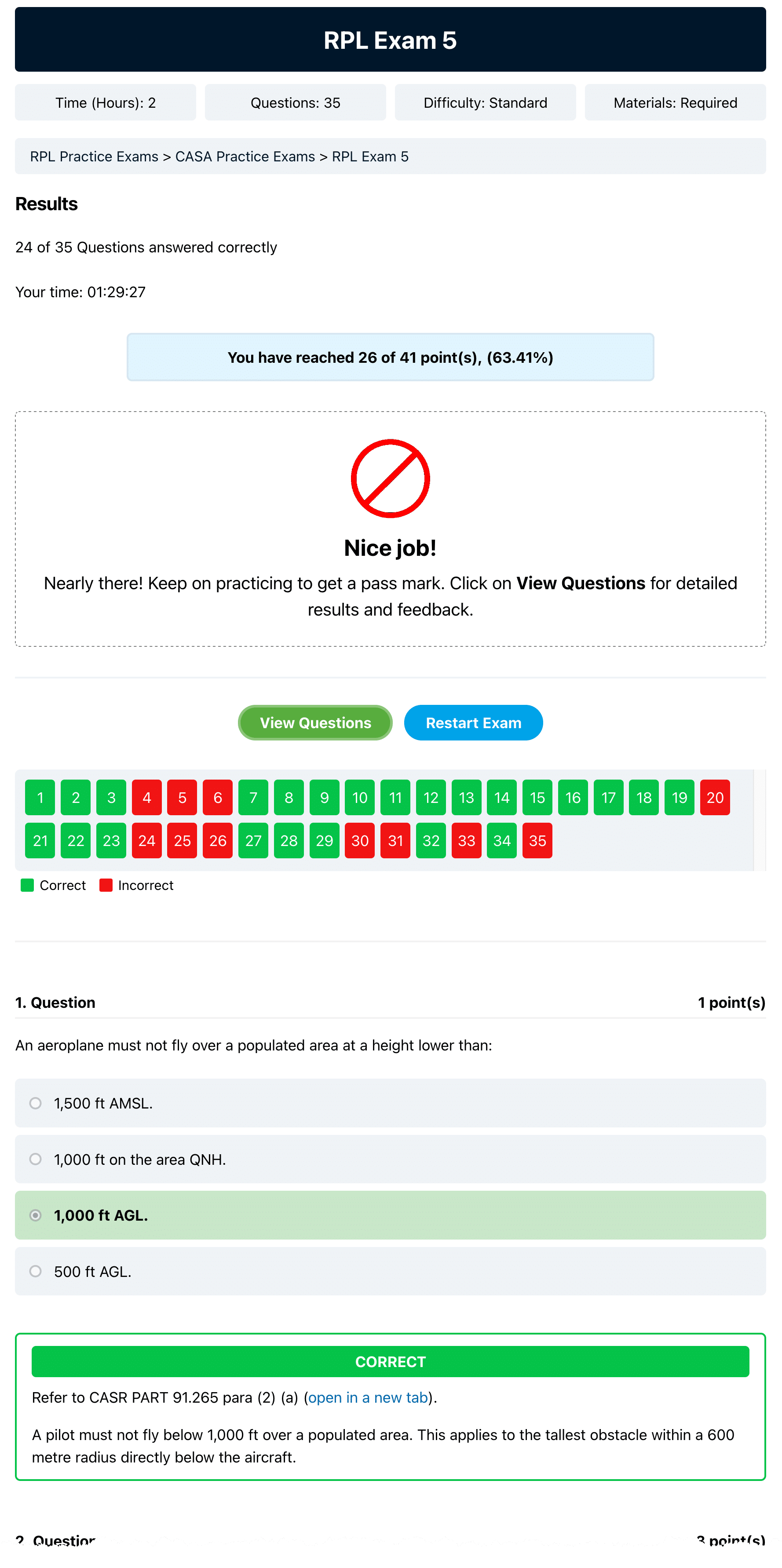Study for the exam
Getting ready for the RPL exam
The world of aviation is obsessed with regulation, exams, and learning. As I understand this world, it seems the primary driver for this obsession is safety. The secondary driver is technological change. Constant learning is every pilot's reality. For every hour of flying, there are multiple hours of pouring through textbooks and taking exams.
After my week of fun at the flying camp, I decided to study for the RPL exam before getting in a plane again.
About aviation exams
In every jurisdiction around the world, there is an organisation that is in charge of regulating civil aviation. In Australia, this is CASA. In the US, it is the FAA. In Europe, there are many.
As I am flying in Australia, I have to learn to rules and regulations designed and enforced by CASA, and pass the many exams. Each license has its own syllabus, but all syllabuses draw from the same source of legislation and rules.
For example, for the RPL exam, a student pilot has to show adequacy on the syllabus in Part 61 Manual of Standards (MOS) schedule 3 - units 1.1.1 BAKC, 1.1.2 RBKA, unit 1.5.1 RFRC, unit 1.8.1 RMTC and 1.6.1 PHFC and also know the content of the RPL, PPL and CPL (Aeroplane) workbook.
For the PPL exam, the student is tested on their knowledge on the syllabus in Part 61 Manual of Standards (MOS) schedule 3.
All this is very confusing for a new pilot, to say the least. There are ground schools where a qualified instructor can help students make sense of it, however I was too busy with work to attend one and preferred to study at home. So I had to figure out what is needed, how to learn it, and how to know that I am ready for the actual exam. I will discuss this later.
It is important to know that I did not have to pass the RPL exam to start flying lessons. I could choose to leave the exam for later, and get started with lessons at any time. However, after discussing this with Bob (my flight instructor), I decided to pass the exam first, and then start with the lessons. The sad truth is that study and exams is boring. Flying is exciting. Many students to the exciting thing first, and hit a wall when they try the boring thing, and never recover. As a general rule in life, I do boring first and fun second.
I also feel that having done all this study (and having passed the exam) has prepared me much better for the flying lessons. I have a much better understanding of aerodynamics, airplane performance and engine management, VFR rules (Visual Flight Rules), meteorology, and aerodrome operations than if I had chosen to work on the exam later.
How I prepared
I started study during a very busy time at Tech Explorations. This is generally the case, and there is rarely "down time" that I can count on for study.
Study schedule
So, I made RPL study part of my daily work. To get things going faster, and to make sure I would stick with the new schedule, I dedicated one full week to study. This allowed me to make rapid progress through the basics. Understanding the basics would ensure that I would know what I am doing and why once I fell back to the regular daily study schedule.
Once the week-long hothouse was over, I imposed a daily study of 1.5 hours, starting at 3pm. At 3pm, every weekday, I would stop other work and start RPL theory study. On Saturdays and Sundays I did online RPL tests to check my understanding of the materials (more about this later).
This lasted from early April, when I did the week-long hothouse, to end of June. I did not keep a long, but roughly, this is how I studied:
- Early April: 7 days dedicated to study x 6 hours = 42 hours.
- From mid-April to mid-June: 1.5 hours x 5 days per week = 75 hours
- Total is approximately 120 hours
Now, let's look at the materials.
Study materials
As part of the flying camp, I had the prescribed text book, Bob Tait's RPL/PPL Study Guide Volume 1. This is the book I used during my hothousing. During that week, I was able to complete around half of this book, including all questions and mini exams. This book gave me the basics of aerodynamics, engines, performance, and airplane systems and instruments.
Progress was very slow. Many topics in aviation are not intuitive. For example, understanding the relation between roll and yaw requires is not obvious because it is now something a non-pilot has experienced. Things get even more weird when we get to performance issues, air law and (my most "hated" topic) meteorology.
After that first week, I continued for two more weeks until I finished Tait's book. That's when I added new resources to my study.
The first new resource was a series of online RPL practice exams from Pilot Train. Tait's book contained a voucher for three free tests, and I purchased additional RPL practice exams. I also purchased additional RPL practice exams from Launch Ready Exams.
Both sets of practice exams were excellent and somewhat complementary. There were questions in Pilot Train's exams that I did not find in Launch Ready exams, and vice versa. However, I must mention that a big plus for the Pilot Train exams was the comprehensive feedback in every question. The feedback even provided links to source materials so the student can see why their answer was right or wrong. With the Launch Ready exams, I had to spent a lot of time trying to find the source materials.
The practice exams consisted the core of my preparation for the real exam from this point onward. I repeated each exam until I scored at least 90% (the real CASA RPL exam has a pass score of 70%).
I used the practice exam questions as prompts for research and learning. During the practice exams, I looked up information from the printed materials that CASA allows to use during the exam. This was a far better way to learn, instead of reading the materials cover to cover.
For the RPL exam, I used these materials (all printed as digital materials are not allowed in the actual exam):
- ERSA (En Route Supplement Australia)
- Plain English Guide for new flight operations regulations
- Visual Flight Rules Guide.
- Aeronautical Information Publication (AIP)
- Part 91 of CASR General operating and flight rules
- Part 91 (General Operating and Flight Rules) Manual of Standards 2020.
- An E6B calculator.
Most of this content relates to legislation. This is the part of the study that confused me the most. The Visual Flight Rules Guide Australia website helped me there. This is an excellent resource that help aviators navigate the web of legislation and how everything relates. For example, how does AIP and ERSA relate to CARs? Find out the answer here.
Exam day
I felt ready for the exam when:
1. I was able to consistently score around 90% on the practice exams without first doing a revision.
2. When I was totally sick of studying anymore!
So, I booked the RPL test at the Flight school office for mid-July. Flight school Flight School collaborates with the Scouts Air Activities Center and provides the flight instructors. This was a natural choice for me.
In the run-up to the exam, I relaxed my study schedule. I continued studying, but at a slower pace. I also continued taking practice tests to prevent forgetting anything that I had worked hard to learn.
Interestingly, I did not feel any stress. As a student, I always felt a lot of stress prior to an exam, but not this time. I am much older and more relaxed in general, however I reasoned that (1) I felt well prepared, and (2), worst case scenario in case I fail the exam is to do it again a couple of weeks later. No big deal.
On the day of the exam I drove to Camden and got there an hour early. I spend the time listening to the ATC on my radio, and looking at planes.
The examiner came a few minutes before the test, and setup the test computer in one of the briefing rooms. After some technical issues with passwords etc. (typical IT issues), I finally started the test.
First few questions were OK, and felt I had them. Then I hit some turbulence (ahem) when I got to eight maximum difficulty meteorology questions. Remember, meteorology is my weakest area. There is not much about this topic in the Tait book, and only a few questions in all practice tests I had done. I expected 2-3 such questions in the RPL exam, but not eight!.
My strategy for hard questions is to skip them and come back later. So I continued.
I got questions about seat belts (also a topic of confusion for me), aeronautical charts (ditto), sensory illusions (totally counter-intuitive by definition), take-off and landing distance calculations, and glide speeds. Those are the questions I remember.
I answered all questions I felt confident quickly, and spent a lot of time on the rest. The the rest were many.
In my practice tests, I typically needed around 1h 15m. In the real exam I finished at 1h 59m. With one minute to spare!
I knew if I had passed it would be a close call, and it was. But hey, a pass is a pass. The pass score meant I was free to start flying lessons without the hassle of the RPL exam.
But, I have a knowledge deficiency that I must address because, guess what... I will be re-examined on the same syllabus in the PPL exam!
But I will worry about this later. For now I'm glad I can move on. Flight training is next, and I'm ready to add hour 6 in my log book!
Don't miss the next flight log
Leave your email address by clicking on the button below, and I'll let you know as soon as I publish my next flight log. No spam, ever.
Watch on Youtube.
Start here.

Not ready yet...
The study source materials that are allowed in the actual exam. There's also a circular analog calculator, the E6B.
The recommended textbook, RPL/PPL Study Guide Vol 1 by Bob Tait.
I spent a lot of time on child restraints and seatbelts.
The entry on Camden aerodrome in the ERSA.
One of the most useful pages in AIP: crosswind and headwind component table.
In VFR, pilots are ultimately responsible for maintaining separation. Knowing the right-of-way rules is good to know (page from the CASR Part 91 Plain English Guide)
A detail from AUS PCA, Planning Chart Australia.
